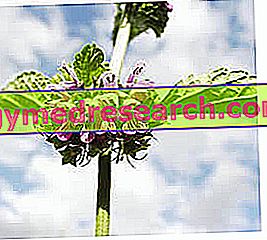Ballota: introduction
"Ballota", "black marrubio" and "marrubio fetido" are common terms attributed to Ballota foetida, known - as the vulgar names predict and the botanical name - for the unpleasant smell emanating from the whole plant. But the unpleasant aroma of ballota, such as to be defined precisely fetid, must not mislead: in fact, the plant is widely exploited for phytotherapeutic purposes, in particular to combat anxiety, stress, menstrual pain, irritability and cough . During the disquisition, we will analyze the general and botanical characteristics of ballota, as well as phytotherapic and herbalist characteristics.

Generality
As stated above, the ballota plant is known above all for its bad smell: for this reason, over the course of history, it has assumed a multitude of rather disparaging appellations, such as fetid and cimici marrubio. But the unpleasant ballota plant not only has the smell: in fact, even to the taste, this is bitter, acrid and - for some - even nauseating.
It should also be pointed out that the common term "marrubio" attributed to ballota does not refer to the proper horehound ( Marrubio vulgaris ).
The name of the genus (Ballota) derives from the Greek, and refers to "refusal, refusal": the reference to the Greek expresses in such a subtle way - as ironic - the aversion of man and animals to this plant, precisely because of the its bad smell, albeit characteristic and easily distinguishable, of ballota.
Botanical description
In botany, ballota is also known as Ballota nigra subsp . Foetida, belonging to the Labiate family, the same as lavender, mint, rosemary, sage, etc. The genus Ballota includes about 35 different species, typical of temperate countries in Europe, Western Asia and North Africa. It grows easily especially in uncultivated and wild areas: in this regard, it is understandable how the plant is widespread in Europe.
The ballota plant can reach variable heights: some species, in fact, grow only up to 40 centimeters, others instead, reach almost a meter and a half. The stem, woody and covered with a light down, is quadrangular and not very branched.
The root is tap-shaped, while the leaves, opposite, have an oval or heart shape, with a serrated and irregular margin. The flowers, beautiful and purple, are bilabated, grouped in axillary glomeruli.
The ballota plant grows up to 1, 300 meters above sea level, preferably in calcareous soils.
Chemical analysis
Numerous chemical components have been isolated in the ballota, clearly exploited in the phytotherapy field: caffeic acid, saponins, dipertenoids (ballotenol, ballotinone, marrubiina), glycosylated flavonoids, and betaine.
Only in recent years, a further class of chemical components has been isolated: these are phenylpropanoid glycosides, to which the neurosedative and antioxidant action is attributed.
Property and uses
As can be guessed, the ballota plant is not used for food, given the particularly unpleasant smell and taste. However, ballota is widely used in the herbalist field: the drug consists of the whole dried plant.
If in the past numerous relaxing and vulnerary properties were attributed to the ballota, currently the drug is used in particular as an antispasmodic, tranquilizer, sedative and antitussive. Again, ballota can be used during the premenstrual and menopausal phases, in order to reduce the state of anxiety and irritability that characterizes the two periods.
The infusion of ballota is not a recommended herbal practice, given the unpleasant smell; however, it is still possible to prepare the infusion to take advantage of the plant's cholagogue abilities. In this case, it is advisable to correct the bitter taste of ballota with corrigens, such as mint, licorice or fennel.
Summary
TO FIX THE CONCEPTS
| Ballota: terminology | "Ballota", "marrubio nero", "cimiciotta" and "marrubio fetido" → common terms Ballota foetida → botanical name
|
| Ballotta: sensory characteristics | Odor: unpleasant, acrid Taste: bitter, nauseating View: rather decorative plant, with beautiful and colorful flowers |
| Ballota: etymology of the term | "Ballota" derives from the Greek: rejection, refusal → aversion of man and animals to this unpleasant-smelling plant |
| Ballota: botanical description |
|
| Ballota: chemical compounds |
|
| Ballota: phytotherapeutic uses | Drug: whole dried plant antispasmodic Tranquillate Sedativa antitussive Reduces anxiety in the premenstrual and menopausal period Colagogic properties → Infusion: correct unpleasant taste and smell with corrigens drugs |



